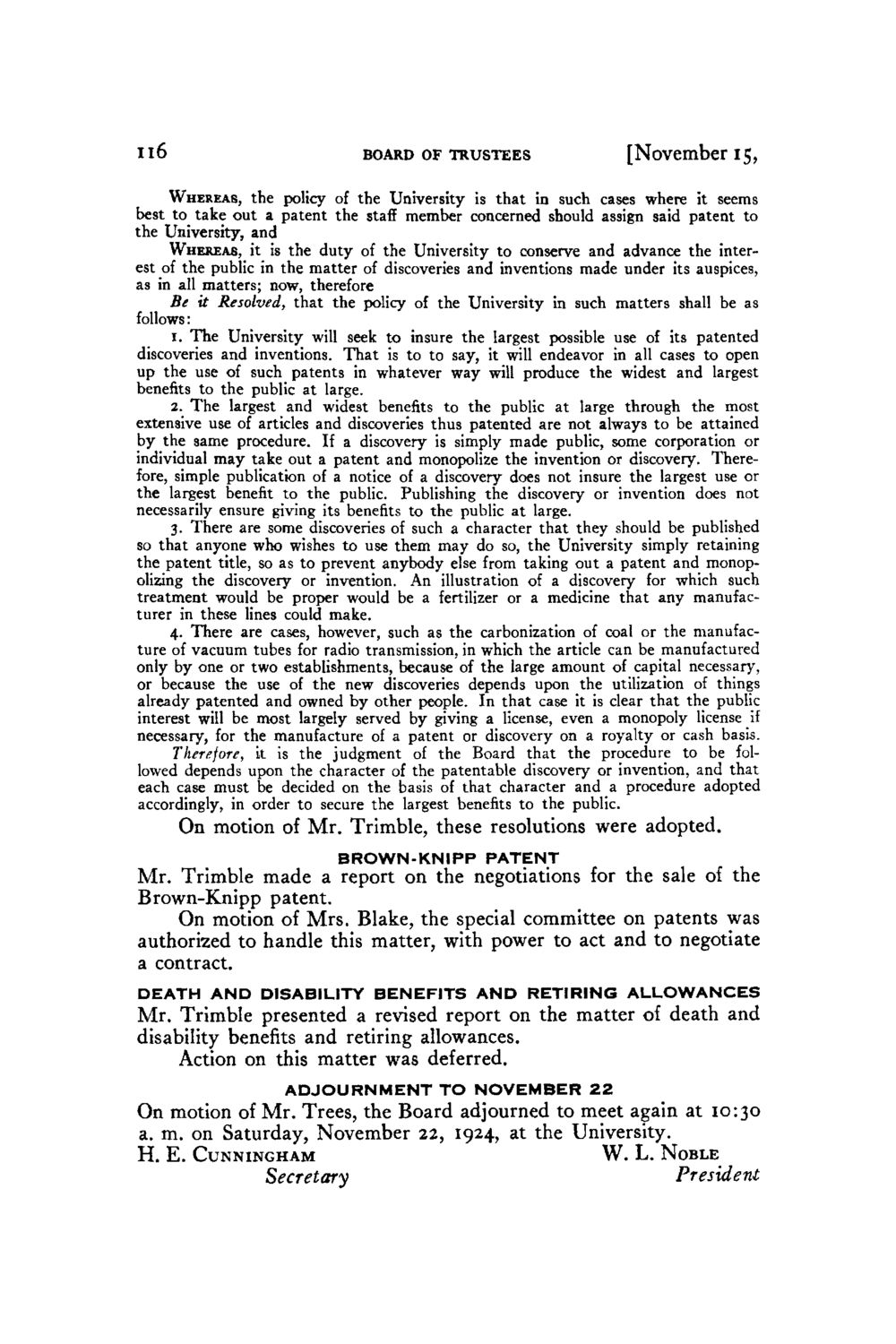| |
| |
Caption: Board of Trustees Minutes - 1926
This is a reduced-resolution page image for fast online browsing.

EXTRACTED TEXT FROM PAGE:
n6 board of trustees [ N o v e m b e r 15, Whereas, the policy of the University is that in such cases where it seems best to take out a patent the staff member concerned should assign said patent to the University, and Whereas, it is the duty of the University to conserve and advance the interest of the public in the matter of discoveries and inventions made under its auspices, as in all matters; now, therefore Be it Resolved, that the policy of the University in such matters shall be as follows: 1. The University will seek to insure the largest possible use of its patented discoveries and inventions. That is to to say, it will endeavor in all cases to open up the use of such patents in whatever way will produce the widest and largest benefits to the public at large. 2. The largest and widest benefits to the public at large through the most extensive use of articles and discoveries thus patented are not always to be attained by the same procedure. If a discovery is simply made public, some corporation or individual may take out a patent and monopolize the invention or discovery. Therefore, simple publication of a notice of a discovery does not insure the largest use or the largest benefit to the public. Publishing the discovery or invention does not necessarily ensure giving its benefits to the public at large. 3. There are some discoveries of such a character that they should be published so that anyone who wishes to use them may do so, the University simply retaining the patent title, so as to prevent anybody else from taking out a patent and monopolizing the discovery or invention. A n illustration of a discovery for which such treatment would be proper would be a fertilizer or a medicine that any manufacturer in these lines could make. 4. There are cases, however, such as the carbonization of coal or the manufacture of vacuum tubes for radio transmission, in which the article can be manufactured only by one or two establishments, because of the large amount of capital necessary, or because the use of the new discoveries depends upon the utilization of things already patented and owned by other people. In that case it is clear that the public interest will be most largely served by giving a license, even a monopoly license if necessary, for the manufacture of a patent or discovery on a royalty or cash basis. Therefore, i is the judgment of the Board that the procedure to be folt lowed depends upon the character of the patentable discovery or invention, and that each case must be decided on the basis of that character and a procedure adopted accordingly, in order to secure the largest benefits to the public. O n motion of M r . Trimble, these resolutions w e r e adopted. BROWN-KNIPP PATENT Mr. Trimble made a report on the negotiations for the sale of the Brown-Knipp patent. O n motion of Mrs. Blake, the special committee on patents was authorized to handle this matter, with power to act and to negotiate a contract. DEATH AND DISABILITY BENEFITS AND RETIRING ALLOWANCES Mr. Trimble presented a revised report on the matter of death and disability benefits and retiring allowances. Action on this matter was deferred. ADJOURNMENT TO NOVEMBER 22 O n motion of Mr. Trees, the Board adjourned to meet again at 10:30 a. m. on Saturday, November 22, 1924, at the University. H. E. Cunningham Secretary W . L. Noble President
| |